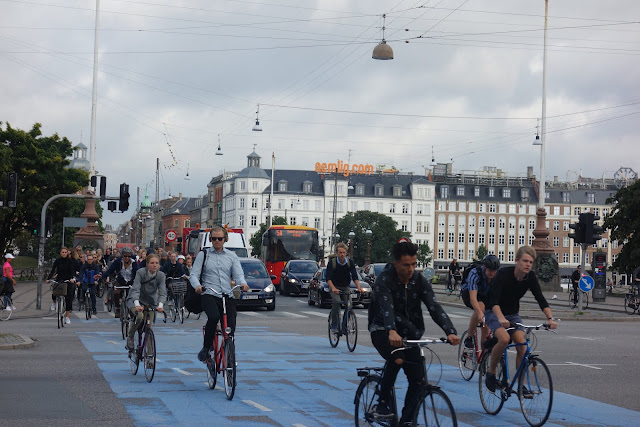
Safety at the World’s Busiest Cycle Intersection (Copenhagen) from STREETFILMS on Vimeo.
Our friend Clarence of Street Films fame was in town last week to further showcase what makes Copenhagen such a life-sized city. This wasn’t his first time. Just a couple years ago we showed him around, checking out the innovative infrastructure that treats bicycle riders with respect. And before that, we showed Street Films around for Cycling in Copenhagen, through North American Eyes.
This time around we thought we’d zoom in a little, taking a more detailed look at the unsung hero of any intuitive and reliable cycle network, the intersection. We met early Friday morning at Søtorvet, the world’s busiest bicycle intersection, with 42,600 bicycle riders every day. 86 percent of all traffic moving through Søtorvet is by bicycle! And don’t think this impressive split is just the status quo, or a fluke. Nope, the City of Copenhagen has made a series of strategic decisions over the past ten years, including widened cycle tracks, public transport investments, and traffic calming initiatives, to encourage the logical modes of transportation.
With such heavy traffic flows, it’s incredibly important to design an intersection that is logical, intuitive, and safe. And one of the simplest ways to insure safety, is to ensure bicycle riders are visible! Three simple design interventions, set back stop-lines, dedicated bicycle signals, and cycle crossing guides, are observed in many Copenhagen intersections and can go a long way in making all road users more comfortable.
Set back stop-lines - This simple design measure improves safety without making any impact on travel times for cars. Setting the stop line for cars five metres behind the cycle stop line ensures, at the very least, that cyclists will be out of the blind spots for a lorry waiting to turn right. Whatsmore, set back stop lines make pedestrians more visible as well.

Dedicated bicycle signals - By giving cyclists their own dedicated traffic signals, both bicycle riders and cars feel more secure travelling through an intersection. The signals are typically placed lower than those directed to cars, putting them directly in the line of sight of the typical cyclist, at least 1.5 metres from the cycle track.
A simple benefit of having dedicated signals is to get cyclists out into the intersection just a couple seconds before cars. This ensures that cyclists are out of any possible blind spots and highly visible. Once the dedicated signal for cyclists has finished, cars are then allowed a couple additional seconds to clear the intersection and complete turns. Like at Søtorvet, dedicated bicycle signals can also easily be combined with set back stop-lines to further improve safety and sense of security.

Blue cycle crossing guides - Once traffic is moving through the intersection, blue cycle crossings help maintain visibility, informing all modes where to expect bicycle traffic. As a colour choice, blue (unlike red for example) tends to age well, maintaining its vibrancy through its lifetime. Danish studies have shown that no more than two blue cycle crossings should be added to one intersection. Any more and the intersection becomes overly cluttered and, in turn, not as safe.

These three design elements are only a few of the simple, yet effective, design elements that go a long way in making a legitimate choice of transportation here in Copenhagen. Depending on the size, capacity, and speed of each intersection, there’s always a design oriented solution.




